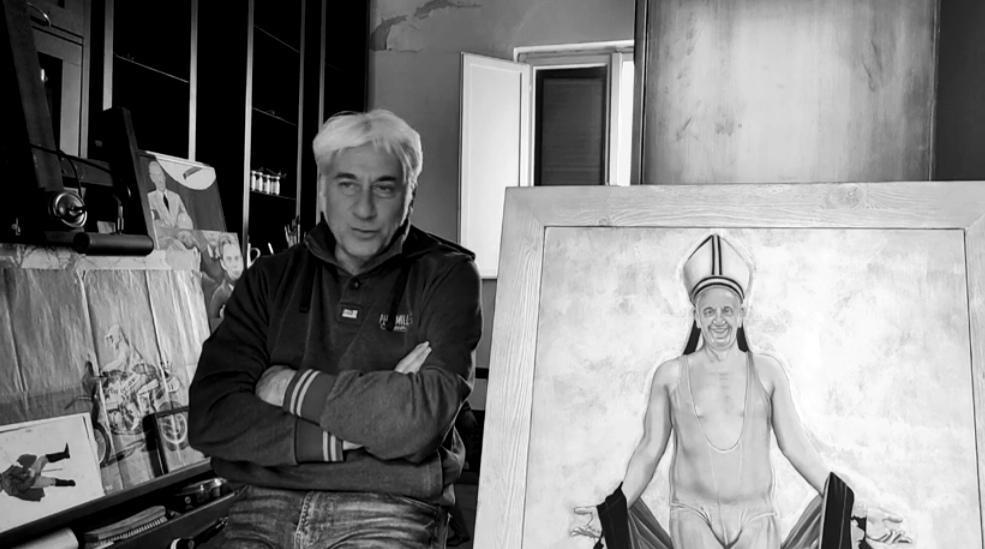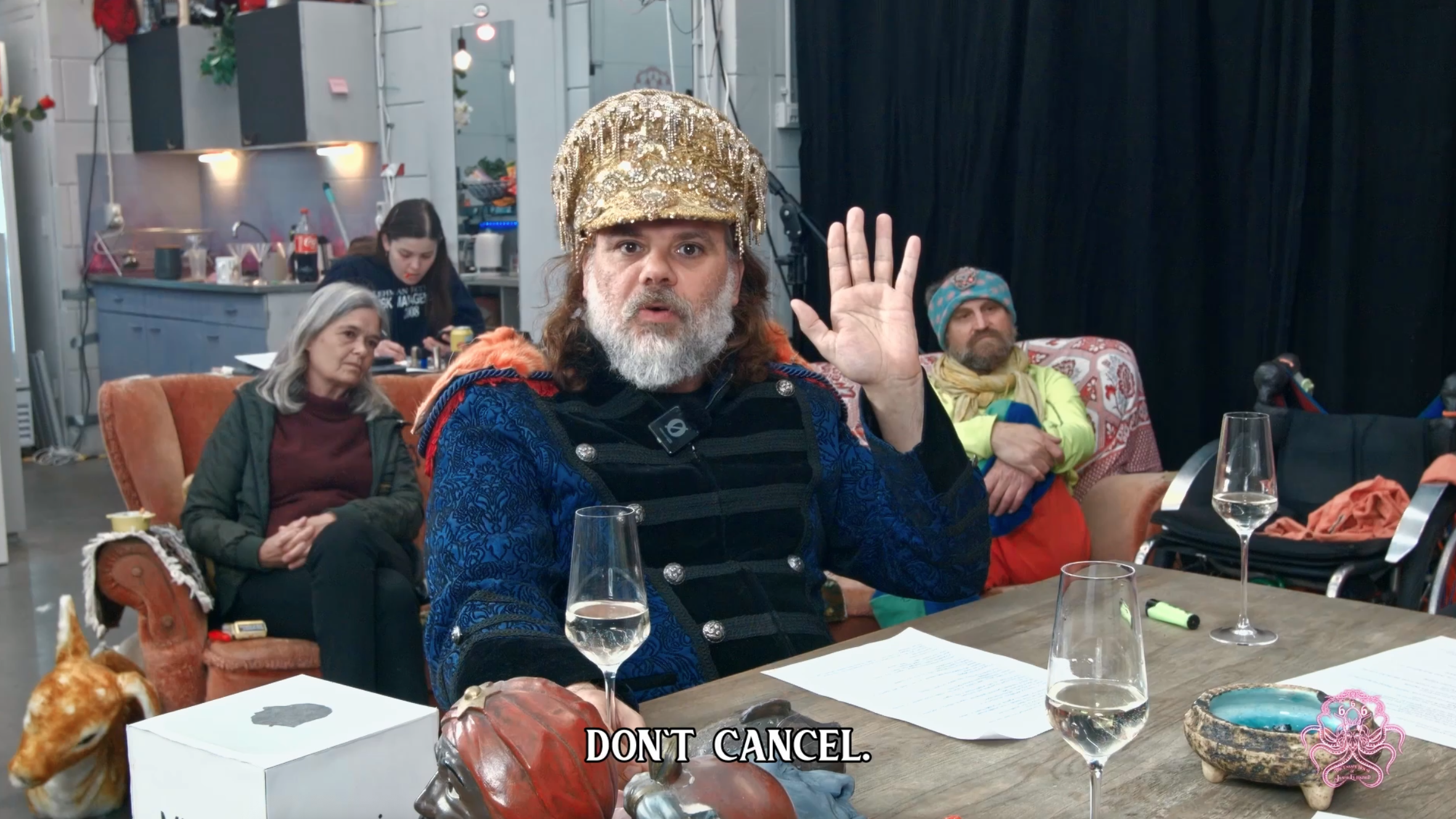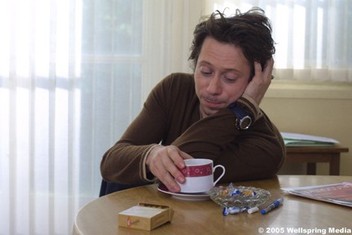You may want to have a pen and notepad ready for this one, such is the gargantuan level of artistic reference points cited by Italian lawyer and polarizing artist Elio Mascolo. Mascolo’s art brutally and brilliantly takes aim at such seemingly untouchable public figures that it makes one wonder how the Italian law system hasn’t already had him *gasp* cancelled. Mascolo is an interviewer’s wet dream and full of tremendous statements that make him instantly quotable. In this lengthy exchange, we cover modern-day threats to artistic freedom, his career as a painter-lawyer, cancel culture, the EU, public sector bureaucracy, Greta Thunberg, the Pope, Mascolo’s ‘vintage’ heterosexuality as well as a whole load of his own and well-known others’ philosophy that demands to be reread, noted and preserved.
Mr Mascolo, I’ve never spoken to nevermind interviewed a lawyer who is also creative. How do both vocations affect each other?
Yes, I’m a lawyer but I’m a teacher too – I teach the history of the Byzantine Empire and history of the Balkan countries in Sancti Cyrilli Universitas in Malta and in the public Universiti of Valona in Albania. Both of these commitments provide me with many hints and ideas, but they do not ‘technically’ affect what I paint. Hardly any one of my paintings was induced by the object of my profession. I have often (and happen) to meet good characters for a painting or colleagues who paid well for a portrait. Strangely, none of them wanted a portrait wearing a toga or discussing a trial. Sometimes I have a female subject, but then I almost always paint her naked or with clothes that inspired more agreeable instincts than those induced by a toga. You always have to dig to find something.
What kind of law do you practice?
I am an administrative lawyer. My opponent is always the public administration and I hate it with all my soul.
I’ve read you say you are a lawyer for ‘pleasure’. What kind of pleasure does that profession give you?
Like I say, I deeply despise the public administration, obtuse laws and bureaucrats. I began to be a lawyer for the pleasure of opposing all this and, often, to beat them. But I’ve been a lawyer for 20 years. After the first ten I thought that the public administration and the state bureaucracy are a relentless Moloch. You can win against him a thousand times, but the day after he will pass new laws against which what you have obtained up to then will no longer have any value. Over the following ten years I became more and more convinced that my clients are no better than the administration I despise. Most of them are just people who don’t want to pay taxes or cover up illegal activities; they are the two sides of the same coin. Now I don’t enjoy it anymore. So, at the end of this year, I decided to return the toga … another cycle is over.
How do you find time to be creative?
Every moment of one’s existence is a creative moment, you just need to have enough attentive eyes and enough rich, intense dreams but also a mind capable of creating infinite rhizomes. In fact, I think that the relationship that a painter has with reality has a thousand facets and presupposes a particular quality of the gaze. Faced with a gesture or a landscape, the painter must bring out the conscience details, fragments, reflections and sensations they are generally unaware of and that normally escape. The expression with the mechanism of the real becomes universal, pronounced on behalf of everyone and elaborated on an articulated cultural background: a network of references, unusual combinations, revealing symmetries. It feeds on relationships, cultivated for years or burned in a few meetings, and above all, born from the constant confrontation with the society of its time, in all its aspects, even the most superficial and ephemeral. My ‘inspiration’ is nourished by this reality, by producing ‘surrealist’ observations on human existence. The red thread of my paintings flow from the teeming movement of life itself.
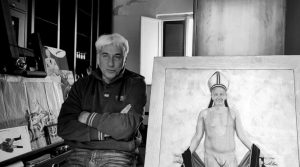
Why or do you think it’s important for art to reflect the artist; authenticity is obviously essential?
I believe that the art expressed and produced by an artist (painter, musician, poet or scammer) can only be the reflection of his skills and ideas. If you don’t express yourself authentically, if you have to strive to be authentic, then you are just an imitator, and you don’t have much to say. So in art (but also in other fields), there are ‘talents’ and ‘geniuses’. The talented man paints, composes verses or music or novels and his works are welcomed by the public. The talented man knows how to please and is rewarded by success, he gets honours and money (the original meaning of the word talent) but his work will not be independent of public consent. He will be successful but he will not have created anything important. The man of genius, on the other hand, creates without caring about the public. Generally, his works are rejected or are imposed by their authority, not by their power of seduction. The future belongs to the man of genius, but the present usually rejects him, often with violence.
Jean-August Ingres stated, “…with talent you do what you want…with genius you do what you can…”
How did you become a lawyer and as a quick follow-up, is painting more of a hobby?
I became a lawyer because my father, who was a lawyer. My older brother is a lawyer, my younger brother is a lawyer, my uncles are lawyers or judges ….in exchange I asked him to be able to study something else as well. So, graduating in law in Bari, I also graduated in history in Rome and in the restoration of paintings on canvas, wood, and frescoes in Florence. After my studies, with a high school friend of mine, I opened a painting restoration company and for seven years I worked for the church and the superintendency of artistic heritage of my city (Bari), then due to a malignant carcinoma caused by organic solvents I had to leave this business. So I started being a lawyer. It was January 2000 (my father’s dream was fulfilled …) but the courts are sad, grey and boring. With my degree in history (obtained at the Pontifical Lateran University), I first obtained a professorship in a Catholic university in Tirana, after one year I was called to the St. Cyrilli University of Malta and two years ago they offered me a professorship in Valona.
I have been painting and drawing since I was three years old. My mother gave me a box of colors and a sketchbook. I never stopped. Now through painting, I focus and ‘live’ in the world, transforming it with the utmost freedom of spirit and with the most prolific and boundless imagination that the world itself inspires in me. Painting enabled me to completely abolish common logic in favor of an imaginative, surreal and subconscious expression. With painting, I can reproduce mental traces built on associative mechanisms and generated by unexpressed sublimated realities. So painting is not a hobby, painting is the air I breathe.
When looking at your works, it seems that you firmly believe in the need for free speech and the right to offend…
Pablo Picasso said: “Painting was not invented to decorate apartments, it is a weapon of offense and defense from the enemy”.
Art is a very powerful means of expression. Now, I don’t think art can kill like a weapon but I believe deeply in freedom of expression and thought. Only art can make you say what you want about what you see exactly as you would like, then, everyone is free to take offense as they see fit. Today, more and more, it is becoming difficult to express oneself without someone not feeling offended. It has become easier to feel offended than to be able to offend. An example: I have portrayed dozens of times the woman with whom I lived 16 years of my life, for me she was the most beautiful living being on this world. I often painted her little dressed, more often absolutely naked. When our story was wrecked, she took all the pictures of the paintings I had taken of her to court and accused me of being a sex maniac (given my status as a lawyer, it was a terrible problem). Then she destroyed them all. So, how many men every day are ‘destroyed’ or ‘brutalized’ even only psychologically by companions to whom they had completely trusted? I hate and despise the rampant concept for which any form of ‘approach’ to the other is now criminalized, of any sex. According to the dominant thought currently, art giants such as Picasso, Balthus, Schiele, Bacon, Freud and many others, would have been arrested immediately because of their ‘stormy’ relationships with their partners, models or muses.
In your work you appear to be making a mockery, satirizing, even insulting ‘important’ people – politicians, social activists, the Pope. I do tend to applaud those you pillory.
How do you choose who you paint or ‘take aim’ at?
I do not choose the subjects of my paintings. It is they who offer themselves to my observation, it is they who ‘knock’ at my studio crowding behind the door. The whole of Western society is the primary source of inspiration … its ever-lower level of cultural, ethical, aesthetic misery. The unstoppable decline into which our culture is precipitating without even bothering to die elegantly. In a society that is incredibly suffocating itself with the noose of his paucity. In reality, I don’t think I offend anyone; I oppose with all my strength the imposition of being ‘politically correct’, the most monumental form of sinister hypocrisy that is pulverizing freedom of expression and thought. It is reducing everything to a single thought that a sane person with a shred of cultural and mental dignity cannot possibly bear. Here, often the subjects of my paintings are characters whose ‘impositions’ offend my intellectual dignity.
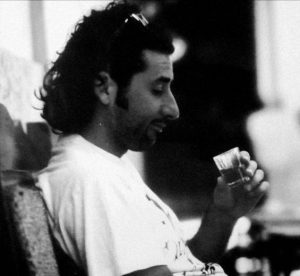
Do you consider yourself a polemista?
I don’t think I’m a ‘polemicist’. Perhaps a cynic (of the school of Diogenes), at least in the way of seeing and facing the things of life. And a heretic in the way of thinking and expressing my ideas with painting. [I’m the] child crying: “THE KING IS NAKED!”
What kind of freedom does art give you?
I don’t know if being an artist makes you more free, I think there are more narrow-minded and obtuse artists than people who have never picked up a brush in their hand but have freedom in their eyes, in their minds, in their souls. I am sure however that a gifted artist knows how to give a more ‘acute’ voice to his libertarian essence. Slaves are born, free you die. The satirical cartoonist Stephan Charbonnier (the director of Charlie Hebdo), 48 hours before his death, published a book whose incipit was a quote from Emiliano Zapata: “It is much better to die on your feet than to live on your knees.” I think exactly the same thing.
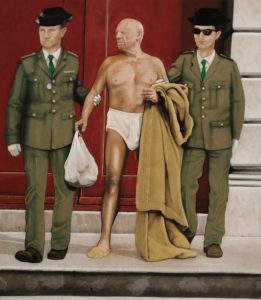
Do you consider yourself a ‘political’ artist?
I am not ‘very political’. I am absolutely anarchist, neither right nor left. My political reference is Buenaventura Durruti. Unfortunately, however, politics, directly or indirectly, alters and manipulates the daily existence of every human being. The total submission of politics to finance. The absolute detachment between politics and people’s real life is the thing I hate and fight most and it is the thing I fear the most; what really frightens me about politics is the silent but unstoppable destruction of social freedom. I wonder if ours is still a free society? By now it is evident that all the conditions for a new “different” dictatorship are being fulfilled. Freedom is being destroyed, language is being increasingly impoverished, truth is being abolished, history is being suppressed, nature is denied, while hatred spreads. Our age has lost all reference. What awaits us beyond the ‘nice’ media?
How does the media affect your creative or artistic work, social versions, or elsewhere?
I’m not (and I don’t care) the influence of the media. At most I get ideas. Basically, I think media is a giant steamroller that flattens everything in its path; a form of total democracy in which everyone can say everything regardless of the value of what they say and who says it. It is a huge cauldron into which millions and millions of ingredients are poured that gives an absolutely indefinable flavor and final shape. Like when mixing all the colors of the palette in one container, the result is a non-color. The media, however, frighteningly influence those who look at art, they ‘suffer’ it. The viewer is absolutely subservient to this neo-language which is now a system of power. Even though the spectator does not understand, he pretends to understand for fear of not being ‘admitted’ to the assembly of the ‘intelligent’, so he appears dramatically more idiotic than he is, and queues up, in silence, to cheer those who mock him …
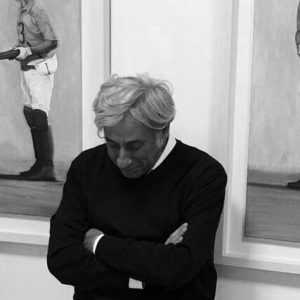
Is it possible to judge art objectively?
I don’t know if art (except for some very evident cases) can be judged in another way that is not absolutely subjective. Certainly, for me, a good part (most of) contemporary art, the conceptual one, the hard one, the one we look at without absolutely understanding anything and inside us we say ‘I could have done it too and even better’, the one that needs thousands of abstruse words to be explained and eyes are no longer enough to admire it, well that art is just a huge hole with something (not much really) around it. And yet, this art of senselessness, of provocation, often of horror, has a history and causes that should be known both by those who adore it and by those who would like to protect themselves from the ugliness inherent in it.
I like your illustration of Greta Thunberg. What’s your personal opinion on her?
She is a little girl unaware of her role, a tiny wheel of a gigantic economic gear artfully built around her, good for any situation. After her performance on the environment, she also ventured into the sea of the Covid pandemic. [ She is] a not too cute puppet well trained. In Italy, if a child, even sick, does not go to school for weeks and remains, like Andersen’s little match girl, exposed to the elements with a sign hanging from her neck on a sidewalk, a judge would have the parents arrested and would order the intervention of social services… I prefer Severn Cullis Suzuky (the girl who silenced the world). Remember the UN Environment Summit in 1992? Little Severn, in absolute autonomy and without mega-organization behind her, said better and earlier the same things repeated by the Swedes.
And then there’s the painting of Pope Francis… which was also funny.
I am an atheist, but I also studied in a Christian and Catholic university, a true institution of the church of Rome. I have an education and a culture deeply imbued with the history of our Judeo-Christian society, with full knowledge of the facts I can therefore say that this Bergoglio is ‘a nice person’ and not much more. Theologically, he is an absolute nullity, he’s managed to do more damage to the church in 7 years than the secular world in 2000 years… perhaps because he looks a lot like Stan Laurel, he tells a lot of nonsense without substance and depth. With him, faith and doctrine have disappeared. He is so Jesuit that he took the name of the first of the Franciscans!
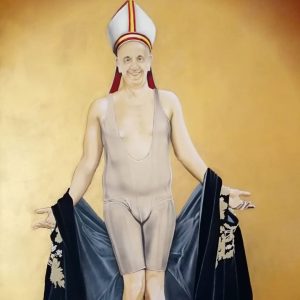
As you know now, I have a Greek wife, but regardless of that fact, it seems to me, quite a healthy thing to lampoon Turkish President Erdogan… a vile character. Your painting insults him brilliantly.
The painting depicting Erdogan humping the Von Der Leyen was painted almost 2 years ago. It is a hymn to the uselessness of the EU in the face of the incredible maneuvers and blackmail of an unscrupulous dictator like Erdogan and the needs dictated by the markets. Turkey is however an excellent economic and strategic partner of Germany and the EU is a foolish servant. It would be useless to list the monstrosities perpetrated by the ‘sultan’ against his own people and many others, ignoring (I don’t want to take a history lesson) the total manipulation of basic civil rights.
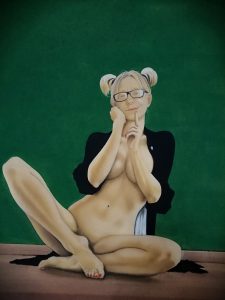
What do you see as the current biggest threat to artistic freedom?
I believe that a truly dangerous threat to art can only come from itself. Since Duchamp’s exhibition of his urinal 100 years ago changed the destiny of art forever, art has since begun to expand its competencies with excessive prodigality; it has lent its guarantees to an infinite number of ‘projects’ that have turned out to be totally unsuccessful, inconsistent, pretentious and all too often insignificant. For a long time now, art has to be seen with the ears and no longer just with the eyes; its existence is only assured if it is supported by a robust theory, i.e. by the most important, sophisticated and grandiloquent terms and adjectives possible that illustrate its meaning to a gullible and good-for-everything public.
Having completely lost sight of the primordial concept that was at the basis of art, that of beauty, which it has evidently long since renounced, and having lost the backbone of aesthetics, art has ended up by flattening itself on vacuous and increasingly disturbing concepts. However, the most insidious danger for the freedom to create and, in my opinion, always more serious, derives (as I have already mentioned) from the unstoppable spread of two monstrous phenomena; the ‘politically correct’ and ‘cancel culture’, two real abominable ogres, those who in my opinion are the armed wing of progressivism, which, find very fertile ground in our now completely anesthetized web society… A society in which freedom has been severely but inexorably restricted; a society in which progress means being constantly monitored and spied on; it means not having a private life, an intimate life, a personal life; it means having to ignore calm, silence, and solitude; it means being repertoire and filed in order to be able to satisfy the markets more effectively.
I enjoy listening to your overall outlook; you cite Emile Cioran for example and many others who I adore.
What inspires you the most, what gives you the strength to create, past living artists, filmmakers, musicians or present?
I certainly love various artists whose way of approaching things I have perhaps assimilated more than their way of painting. Of course, the paintings of Dali and Magritte fascinates me a great deal, the style and line of Schiele and Klimt are absolutely inimitable, as is the unsurpassed technique of Dante Gabriel Rossetti and the Pre-Raphaelites, or the genius of Picasso, Caravaggio or Masaccio, but they already had intuitions and ideas that they realised wonderfully. It is in my reading, in my music, and in what surrounds me and crowds my daily life and, no less important, in the female body, that I find cues, images, ideas and topics that I then translate into frames of imagination. For example, when I’m in Albania for university and experience the chaotic and varied everyday life of the streets of Vlora or the markets of Tirana, I feel like I’m immersed in a screenplay by E. Kusturiza. But when I talk to the people who live and animate those places, I feel as if I were dipping my hands into the ink that flows from the pen of Milan Kundera, all set to music by Bregovic and Satie! So in my memory, images are indelibly printed that will come in handy, sooner or later, in some painting.
As for women’s bodies as inspiration and passion, apart from my now ‘vintage’ heterosexuality (I am white and heterosexual and this makes me an animal in extinction), I believe that only in them is it possible (not always, of course) to merge the beautiful and the sublime. But from Rimbaud, Baudelaire to Rilke, from Garcia Marquez, Orwell or Borges, to Tournier, Houellebecq, Calvino or Camus, from Cioran, Agamben to Onfray, it is among them that I look for emotions and the commotion capable of ‘moistening’ my soul so that it doesn’t dry up too much in contact with the ugliness or paucity that assails reality. Reading and listening to music are my drug. Knowing, feeling and wanting to know and see more and more is my incurable disease. Curiosity is my sea.
I associate with your take that music is a drug – can you talk more about its importance to you?
I believe that music is the breath of the world. I think life without music would be very miserable and I personally listen to music all the time. When I’m working in the studio and if I have a particularly challenging act to prepare, I listen to music appropriate to the difficulty of the moment; as well as when I’m preparing lectures for university or doing research or when I’m painting; and when I’m driving, all the time. I can whistle every note of an infinite number of tunes. One day in court, while walking down one of its huge corridors, I whistled ‘The Man I Love’. A judge looked at me with disgust and said, “Remember you are a lawyer!”
“I remind you that this is Ghershwin”, I replied, “…a little more than most lawyers”. He told me I was crazy and other things I didn’t understand. Every moment of my life clings to a note, a melody.
When my son was born I learnt by heart the notes of ‘Eine Kleine Nachtmusik’ by Mozart. When the little one cried at night, in order not to wake up his mother and make him fall asleep again, I whistled ‘My Favourite Things’ – the version by D. Brubeck, or ‘Riders On The Storm’ by The Doors (maybe that’s why he hates me today). When his mother left with him, I sat on an armchair and played at full volume Chopin’s ‘Farewell Waltz’ and E.L.P.’s ‘Fanfare for the Common Man’.When I’m painting I listen to Bach played by G. Gould, the Goldberg Variations usually or the Concerto No.7 in G minor.… Anyway, I haven’t seen that wonderful child for years now, but every night before I go to sleep I still listen to “My Favourite Things”.
Can you tell me about any upcoming projects or works?
At the moment, apart from a couple of portraits that have been commissioned, I am working on several projects. The first is a small, short exhibition that I have been organising every summer for the last four years in the law firm of a friend and colleague of mine, who opens to art and people his beautiful studio in the centre of a beautiful old village in a small, characteristic town in the ‘Itria valley’, Cisternino. I am also working on three series of themed paintings.
The first one is entitled: “Al più peggio non c’è mai fine”. In the Italian language, to say “Al più peggio non c’è mai fine” is a frightening grammatical error, but these words came out of the mouth of our Minister of Education (F. Fedeli), who was later found to have lied about her qualifications and her entire curriculum. For a country whose Minister of Foreign Affairs (and almost all of its MPs and Senators) does not speak a word of English, it is absolutely normal to have a Minister of Education who does not know his own language. It, therefore, seemed to be a good title for an exhibition on the level of absolute incompetence and inadequacy of some individuals who, however, due to circumstances completely unrelated to their merits, find themselves tragically deciding the fate and lives of many other unfortunate and unwitting people. To each of these characters I have matched a person of completely opposite thickness and value or even worse, for example, to the former President of the Republic, Napolitano, an ambiguous, factious, and instrumentally opportunistic character, I have matched Vaclav Havel, a true Martian compared to ours; to a well-known and influential judge who believes that it is enough to enter a court to be guilty, I have matched R. Freisler, “the Hitler judge”, who thought like ours and condemned to death all the members of the White Rose (as well as thousands of other innocents), just by applying the law.
The second series is entitled “Me Tooooo”. Obviously, I am referring to the well-known Hollywood movement according to which a great many artists (I am obviously referring to painters) who have made the history of universal art, for what had been their relationships with the opposite sex or their partners, would certainly have been tried, arrested and ‘erased’, with the result that today we would not have Guernica or the Deemoiselle d’Avignon or Guitar Lessons or the Lovers or Three Studies for a Crucifixion or Standing by the rags or many others.
The third series is entitled ‘Red Shoes’.
Granted that for me all forms of murder are absolutely unacceptable, regardless of the gender and tendencies of the victims (except for the killing of children which is an even more inconceivable monstrosity), I am quite skeptical about the current emphasis and narrative that a man who kills a woman is worse than any other murderer and a woman killed by a man (regardless of the circumstances) is more of a victim than another murdered person. For me, every death is equally heinous without excuse.
As a male, however, I claim with all my might the right to dignity and truth for the thousands of men who, although not killed by their partners, have been reduced to human wrecks deprived of any presentability and honour, thrown into the most devastating misery and instability imaginable by the very woman to whom they had entrusted (given) their lives without asking for any guarantee. How many men have had everything taken away from them, but above all their lives as fathers? The courts are full of fathers ‘orphaned of their children’ (I know something about it). Living with the ghost of a living child is a daily death that cannot be described, but I have never seen men in red shoes or women condemned for having reduced their unfortunate ex-partner to a non-life. And this for the simple fact that, even under secular law, motherhood is a given while fatherhood is a privilege. I think I’m going to have a hard time finding a gallery owner willing to host and show these works… If you know one, suggest it to me.
Elio, thank you for your time. Grazie.
